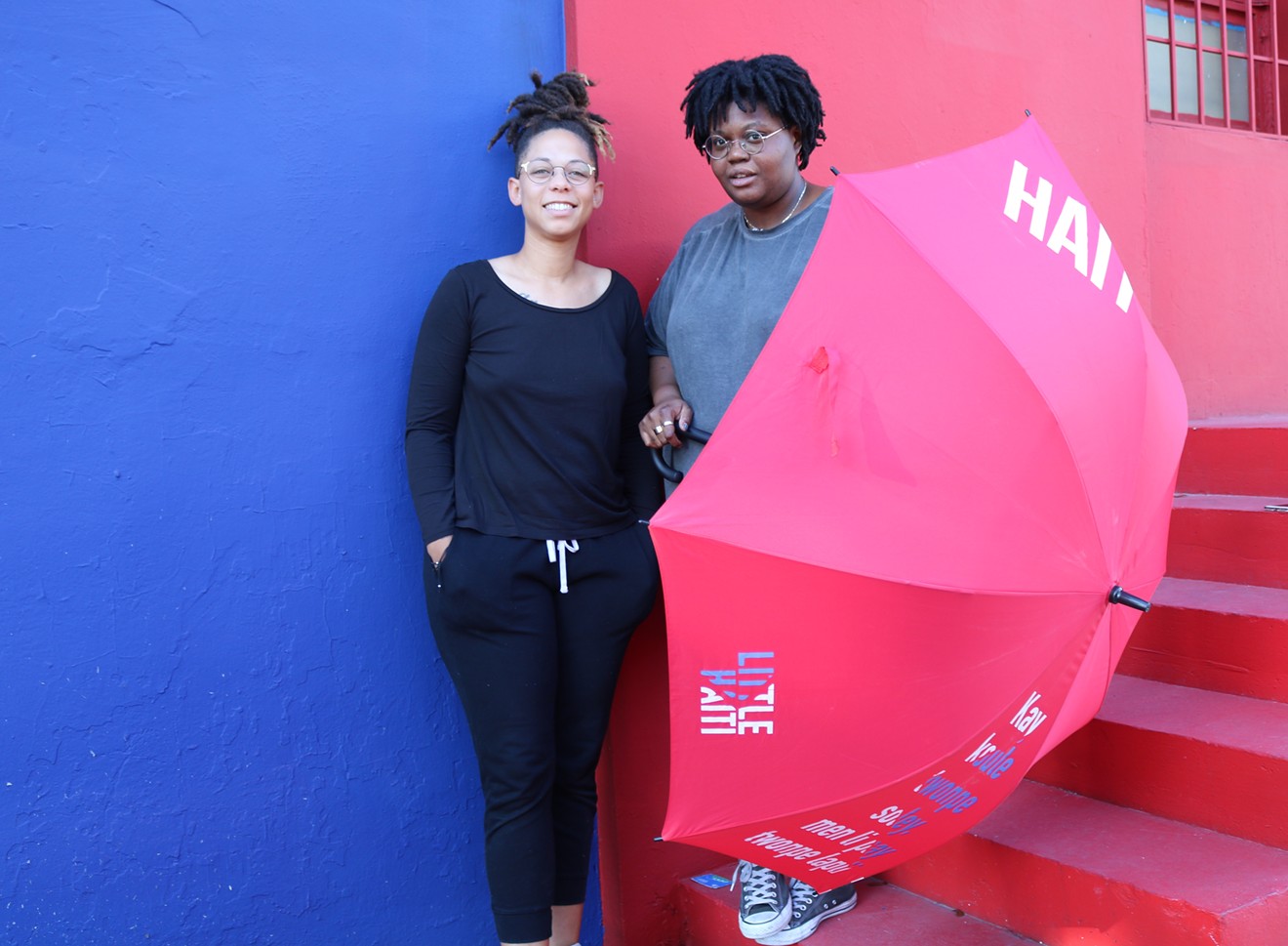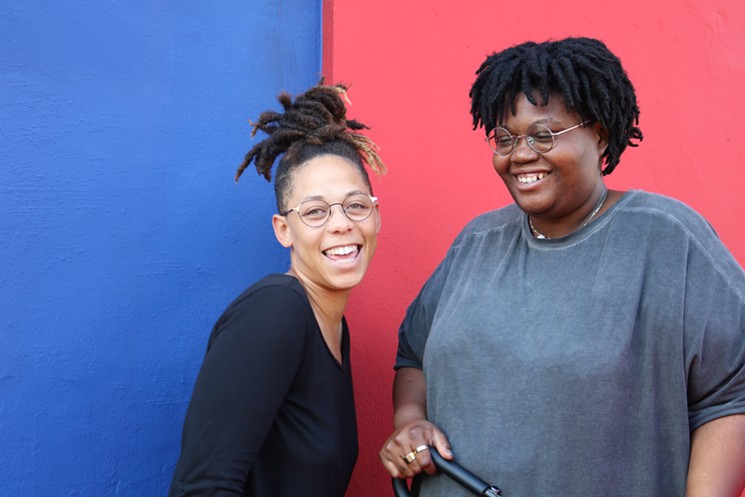The rain was pouring in Little Haiti when housemates Najja Moon and Michelle Lisa Polissaint caught a Miami Design District umbrella floating past their living room window. One of their neighbors had picked it up from a valet station along North Miami Avenue, where they are given out for free during commutes.
But Moon and Polissaint couldn’t shake their unease from seeing the cerulean parasol miles north of its origin. For them, it was proof of the gentrification that has been threatening Little Haiti for years — only this time it had trickled into their community, unknowingly brought in by a community member herself.
The two artists and activists channeled this discomfort into an idea: They would make their own umbrellas for Little Haiti.
“The umbrellas are a tool but also, when it starts to travel outside, it becomes marketing propaganda for the gentrification machine,” says Polissaint.
Moon and Polissaint met in 2017 outside the Opa-locka Community Development Corporation building. Polissaint was there to present an information session on the WaveMaker Grants for Locust Projects, where she works as programs and outreach manager. Moon was the only one in attendance. Polissaint scrambled to find a suitable venue to host the meeting, which had fallen through after the host fell ill and couldn't promote the event adequately. In a squeeze, she invited Moon to her home in North Miami to host the session there.
Within 30 minutes of meeting, the pair had found a synergistic bond. Each artist's talents complemented the work and community outreach the other wanted to accomplish. Since then, the two have lived together in Little Haiti, a community Moon says "chose her" in 2014.
Residents in Little Haiti have been fighting against the whitewashing of their neighborhood for years. After prices in Wynwood and the Design District soared, developers looked north to Little Haiti, where the vocal community has made it clear their priority is preserving the neighborhood’s affordability. But developers are relentless, most recently battling for the Magic City Innovation District, a behemoth project that would combine over 17 acres of residential and commercial space along NE 62nd Street. Critics say the venture would cause rents to skyrocket and displace an already impoverished community, and some plan to voice their concerns at a series of community meetings April 23 and May 6.
"That is a torrential downpour,” says Polissaint. “Once that’s built, it’s going to be a fight to let anything remain.”
In response to the encroaching development, Moon and Polissaint partnered with O, Miami Poetry Festival to create Who’s the Fool?: How to Patch a Leaky Roof, a site-specific public work and photographic archive that addresses the central question of gentrification: Who is this change really for?
The artists designed and produced 1,000 umbrellas that they will place opened on doorsteps in Little Haiti next week — a gift to the community but also an invitation to help combat the changes.
“It’s this juxtaposition of folks carrying around propaganda for the thing that’s making it impossible for them to live there,” says Moon.
Each umbrella will act as a form of visual accountability, reminding people in power that longtime community members need positive investment. The umbrellas feature a Haitian proverb in Kreyol that translates to “A leaky roof can fool the sun, but it can’t fool the rain.” In Who's the Fool, the proverb — whose history Polissaint conjectures dates back to the days of slavery in Haiti — refers to the fine line between community redevelopment and gentrification. Rain, unlike sunshine, can trickle into any foundation.
“Fixing the sidewalks, fixing potholes, making sure there’s proper resources for a community, like trash cans —that’s the sunshine,” says Moon. “But the leaky roof is realizing that the [developers'] intention is not for the people who live here; the intention is to increase value so [they] can turn a profit. It's an investment for the people to come later and when the rain starts falling, it becomes more apparent.”
The design mimics the Design District’s iconic minimalism. Instead of cerulean blue, the umbrellas are bright red, blue, and white, like the Haitian flag, a tribute to the country from which most of the community emigrated and which historically suffered from colonialism.
“In order to colonize people, you have to force them to forget what was there before, so a lot of the proverbs come from the language that is as old as slavery,” says Polissaint, whose parents emigrated from Haiti in the '80s.
The artists hope to continue their project until umbrella stands mark street corners, just like in the Design District.
“You don’t have to carry around this marketing thing," says Polissaint. "You can carry around the thing that talks about you and your people, because Little Haiti is still mostly made up of Haitian people, mostly low income, black and brown people. And that’s who this umbrella should be for."
O, Miami Poetry Festival. Through April 30 throughout Miami-Dade County. Visit omiami.org.
Magic City Innovation District Community Meetings. 5 p.m. to 9 p.m. Tuesday, April 23 and Monday, May 6, at Notre Dame D'Haiti Catholic Church, Parish Hall, 130 NE 62nd St., Miami. Admission is free via facebook.com.
[
{
"name": "Air - MediumRectangle - Inline Content - Mobile Display Size",
"component": "19274298",
"insertPoint": "2",
"requiredCountToDisplay": "2"
},{
"name": "Editor Picks",
"component": "17482312",
"insertPoint": "4",
"requiredCountToDisplay": "1"
},{
"name": "Inline Links",
"component": "18711090",
"insertPoint": "8th",
"startingPoint": 8,
"requiredCountToDisplay": "7",
"maxInsertions": 25
},{
"name": "Air - MediumRectangle - Combo - Inline Content",
"component": "17482310",
"insertPoint": "8th",
"startingPoint": 8,
"requiredCountToDisplay": "7",
"maxInsertions": 25
},{
"name": "Inline Links",
"component": "18711090",
"insertPoint": "8th",
"startingPoint": 12,
"requiredCountToDisplay": "11",
"maxInsertions": 25
},{
"name": "Air - Leaderboard Tower - Combo - Inline Content",
"component": "17482313",
"insertPoint": "8th",
"startingPoint": 12,
"requiredCountToDisplay": "11",
"maxInsertions": 25
}
]













